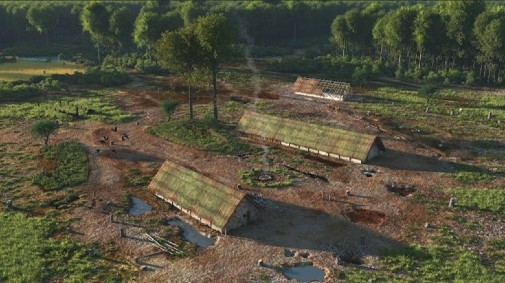More equality in Neolithic society than previously thought, say researchers
Posted on 29 November 2024
 An image of what a typical farming settlement might have looked like. Credit: Mikko Kriek/Municipality of Beek
An image of what a typical farming settlement might have looked like. Credit: Mikko Kriek/Municipality of Beek
Researchers have long known that our human ancestors migrated from the Near East into Europe and brought farming with them, but a new study, led by experts from the Universities of York, Vienna, and Harvard, has shown that this mobility continued throughout the Neolithic, with people networked over large areas.
This means that Neolithic groups didn’t just spread out into neighbouring areas over time, but travelled vast distances, with genetic data showing that some individuals lived far away from family members, painting a more ‘free’ society than is currently envisaged.
The team integrated new genetic data from more than 300 individuals with extensive data sets, including bone studies, radiocarbon dates, burial contexts, and dietary data.
Distant relatives
Studying the genetic links between more than 250 Neolithic individuals has shown that a Neolithic group known as the Linear Pottery Culture expanded over hundreds of kilometres in just a few generations.
Researchers showed that distant relatives existed in Slovakia, Western Germany and Hungary and that studies of grave sites showed no differences in the food that they ate, the grave goods they were buried with, or their origins.
This included finding no difference between the graves of men and women, suggesting that the burial sites were not marked out by differences in the role men and women had in society or on the basis of where their relatives were originally from.
Dynamic community
Professor Penny Bickle, from the University of York’s Department of Archaeology, said: “In recent years our perception of Neolithic communities has started to change due to greater analysis of grave sites, but our new genetic data is another piece of the puzzle that sheds more light on not just the work of these communities but their relationship to each other, as well as their similarities to the way modern humans build communities today.
“We can now see how important broader family relationships were; in a triple burial, long thought to be a mother and two children, for example, we have shown she was their paternal aunt. The three are buried close together with her arms placed embracing the children in a distinct act of care.
“We also know from the items left in grave sites, such as stone tools and pottery, that women played a much more active role in farming work than previously thought and that some women travelled more than men, whilst women in other areas stayed closer to home, showing a much more dynamic community than we perhaps thought possible.”
Massacre mystery
The new genetic data also added more questions to the mystery surrounding the demise of Linear Pottery Culture, which came to an end around 5000 BCE. One hypothesis was that it was a period of violence, with one notable event being the Massacre of Asparn-Schletz in Austria, where over 100 individuals were recovered from a ditch system, with skeletons displaying multiple fractures.
The new study, however, showed that less than 10 of these skeletons were genetically related, challenging the idea that this act of violence was suddenly and brutally enacted on a single community.
Remains include a high number of children and not many young women, opening up the debate as to what this act of violence meant near the end of this community's lifespan.
Conceptions of gender
Professor Bickle said: “The massacre site raises many questions and more work will need to be done on this event to get closer to an answer, but it is interesting to contrast this idea of equal and free societies with this brutal act, knowing that most of the victims were not related to each other.
“Could they have been selected from a larger community and transported; were the young women present but not killed or held captive elsewhere, why children as well as adults - the mystery remains.”
Professor Bickle is currently investigating the lives of women in Neolithic times, challenging some of the views of gender in the past, and showing that women’s role in society and how they were valued, changed as farming moved across Europe.
Professor Bickle said: “Our research shows that conceptions of gender have always been dynamic across different cultural contexts, with no one single impact as societies adopted farming and settled down.”
The research is published in Nature Human Behaviour.
Explore more news

Researchers use robotics to find potential new antibiotic among hundreds of metal complexes
Tuesday 23 December 2025

Text messages could be key to helping TB patients quit smoking, according to study
Monday 22 December 2025

Teenage niece may have shaped Jane Austen’s Persuasion, new study suggests
Monday 22 December 2025

Project to examine how AI is changing the way science is done
Wednesday 17 December 2025

Researcher leads global push to cut tobacco harms in people with mental ill health
Monday 15 December 2025
